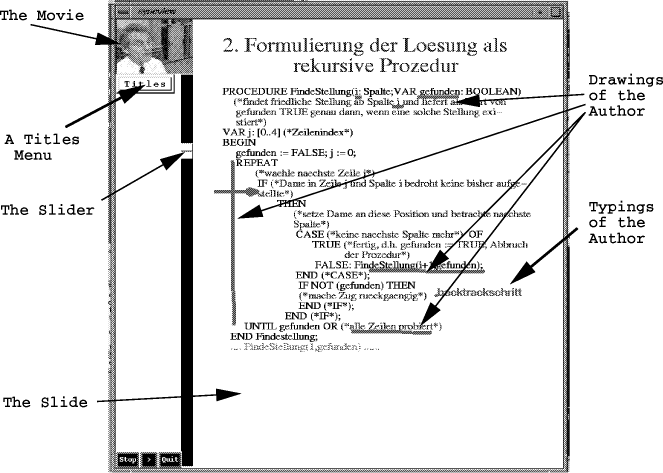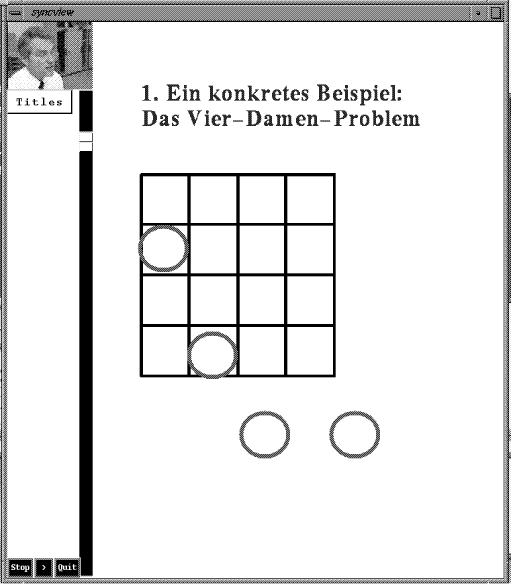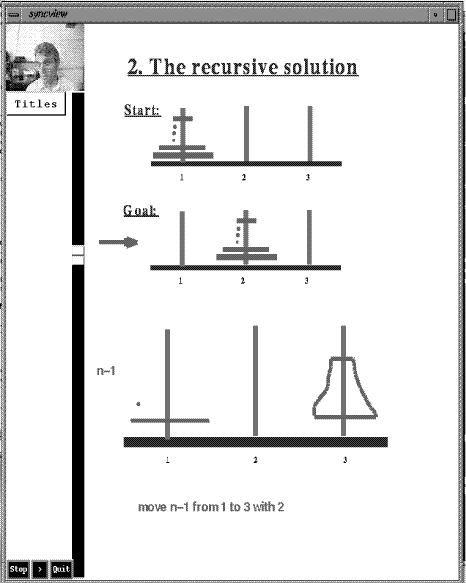| Submission Procedure |
Authoring on the Fly
Institut fuer Informatik Universitaet Freiburg bacher/ottmann@informatik.uni-freiburg.de Abstract: We report about a new way of producing hypermedia documents for supporting teaching at universities. A computer held lecture is automatically converted into the core of a multimedia document and linked together with papers, textbooks, animations and simulations. As an electronic substitute of the blackboard we have used the whiteboard wb of the Mbone toolset and have transmitted the lecture also to remote locations. Our experiments demonstrate that classroom lecturing, distance teaching, and the production of educational hypermedia can be successfully integrated. Keywords: electronic courseware, hypermedia, whiteboard, distance teaching Category: H.5.1 1 Computer Support for Teaching at University Level
Today personal computers and workstations have spread over offices and laboratories not only in departments for computer science in universities all over the world. Teachers, students and even the administrative personnel have access to a wide variety of computer supported services inclusive access to the Internet. This ubiquitous access to computers has resulted in a drastic change in the working behavior of instructors and students. The use of textprocessing, spreadsheeds, and database software has replaced traditional ways of Page 706 writing, calculation and filing. Communication over the Internet by using electronic mail, news groups, conferences, and data exchange, are taken for granted today. The inclusion of computers in college lessons is becoming more attractive since hardware and software have reached a level at which a multimedia presentation of nontrivial content has become feasible. There are already many examples of successful use of new media in college teaching. These examples include computer support for displaying dynamic processes, visualisation of complex phenomena and simulations, as well as the access to full-text- and image- databases. Nevertheless, college teaching is still dominated by the traditional style of lecturing, meaning teaching in the front of the classroom using the chalkboard and overhead projector. And students write their own notes on the professor's lecture. In addition, the students sometimes obtain copies of the transparencies used by the instructor in class. If they are lucky, they may read the lecture material in an accompanying textbook. Especially mathematicians have developed a culture of not using any technology for lecturing at all. By using chalk and chalkboard (and almost no manuscript) they write down all essential parts and slowly develop definitions and proofs. Students go to the lectures because this developmental style of lecturing supports their understanding; reading the same material from a textbook requires more effort. Computer science instructors have learned to use transparencies and the overhead projector in order to explain and comment long programs. A few of them may even use computer animation and visualization in order to explain a complicated algorithm. But the use of multimedia technology for teaching at university level is still an exception. There are various reasons for the loyalty to traditional methods, such as the considerable amount of work and energy associated with the preparation of lectures as multimedia or even as linked hypermedia documents, lacking standards, rapidly changing technology, insufficient experience, and - last but not least - no clear perception of what the right form for passing knowledge is. Page 707 2 Possible Ways out of the Dilemma
Because instructors, as experts for a subject, would likely be little interested in the existing problems with the production and distribution of prepared multimedia for college teaching, it is necessary to search for ways to alleviate their burden while using their specific knowledge optimally. There are at least three possible ways to accomplish this: 2.1 The Team Approach
Teams are formed of instructors responsible for the content, experts for media technique (computer, network technique, design, distribution) and pedagogues (educators, cognitive scientists, psychologists). Together they prepare a theme for employment into college teaching as a multimedia teaching packet. The considerable time-consumption and financial burden with this form of multimedia preparation of content used for teaching results in confinement to content that is stable in the long term and which is standardized and useful in many locations. However, this form also offers the possibility of producing high-quality teaching material. There are already a few convincing examples on various subjects (for example, the CD ROM from Time Life "How Computers Work" [Med93], the CD ROM version of the book from Cormen Leiserson Rivest [CLR90], the physics program Albert [Wue94]). 2.2 Separating Form and Content
The tools to be used when preparing courseware or multimedia material for teaching purpose still dominate today which were conceptualized according to the WYSIWYG principle. Their ever increasing functionality makes it very difficult for the unexperienced and casual user to produce high-quality material. Therefore, we suggested [AOS91], a new way of authoring multimedia courseware and implemented a prototype authoring system, called TRAIN (type and rule directed authoring). The TRAIN-system allows a strict separation of the logical content-structure of a course from its layout-structure. This is achieved by following well established principles underlying modern document preparation systems like LATEX. With the help of LATEX a scientist can bring an article on his research result or even a whole textbook into a form in accordance with the professional quality requirements tradi- Page 708 tionally guaranteed by printers and publishers and completed by specialists. Unfortunately there is no comparable tool available on the market to produce multimedia documents in a similar way. 2.3 Combining Current and Future Lecturing Technologies
Here the goal is to capture as much as possible the various advantages of the traditional form of preparation of college teaching material and to combine them with the advantages of multimedia computer systems. That is, utilize the extensive experience of instructors to structure and present nontrivial content in lectures, but use the computer as an electronic substitute for a chalkboard or an overhead projector. Furthermore, convert a recorded computer lecture into the core of a hypermedia document for offline use and access. The aim is that instructors do not become too much dependent on sophisticated technology but are still able to contribute considerably to the creation of a highly useful hypermedia document for teaching purposes. There are already a few examples (such as the CD-ROM produced as the multimedia proceedings of a scientific conference [Glo94]) which show that high-quality material can result when lectures from conferences, which are held in a significantly traditional manner, are converted into a multimedia document and distributed on a CD-ROM. In the rest of this paper we will report about first steps into this direction, an approach which we have called authoring on the fly in order to express that the process of creating a multimedia document is more a byproduct of a traditionally held lecture and highly automated rather than the result of using a specialized authoring tool. We have transmitted a number of lectures over the Internet using the MBone tools [Eri94], recorded the lectures using a novel program for recording whiteboard sessions, and, finally, converted the lectures into hypermedia documents which can be accessed from a Hyper-G [KMS93] server. The message that we want to communicate by this paper is that on the one hand producing a useful hypermedia document is easier than you think, because we have all the tools available to make it going; on the other hand, if one wants to take the third path of multimedia preparation of teaching Page 709 material for the university, then one does not only have to gather information on the use of existing tools but, at least to some degree, also develop new tools. 3 The Lecture Scenario
We now describe the scenario which we have used in order to deliver a lecture on the computer and to convert it into a hypermedia document. The instructor first decides on the topic to be presented. In our case we have chosen the area of algorithms and data structures, among them backtracking and the Towers-of-Hanoi problem as our first topics. Next he prepares slides as usual using a standard tool like Showcase on Silicon Graphics machines, or Framemaker, or LATEX. The result are colored slides in postscript format. Note that good transparencies should contain less text than a scholarly paper. Just the essential keywords are enough, and, furthermore slides should be used as templates to be filled in by the hand of the instructor while lecturing! The lecture itself is delivered using the computer (we have used a SGI workstation). We used the MBone whiteboard to deliver a computer lecture. The slides were loaded into the whiteboard wb, orally commented by the instructor, marked and illustrated with on-line drawings carried out using the tools which wb offers. Several other people at distant hosts "attended" the lecture via the MBone. They used the MBone tools sd, nv, vat and wb to get the video (about 3 frames per second), audio and also the explanation of the slides using the wb. Students could follow the lectures both locally in Freiburg on student workstations and on remote hosts at different universities in Germany (Mannheim and Munich). There was also the possibility for the audience to ask questions and to carry out actions on the (shared) whiteboard. But, as in most lectures at least at German universities, students do not ask many questions, if the instructor presents a well prepared lecture. The transmission rate and the synchronization of the different data streams (audio, video, and whiteboard actions, in particular slide changes) was completely acceptable both on the local and at the remote sites. Feedback from the audience revealed that the video of the lecturer is not as important as the sound and the action on the wb. So even a frozen picture Page 710 of the lecturer, combined with sound and wb movements would be a possible way of teleteaching. 4 Converting a Computer Held Lecture into a Multimedia Document
The lecture was recorded on a S-VHS video tape, which was later digitized (audio and video) with the SGI capture tools. The capturing of the audio and video stream in a sufficient quality needs a powerful hardware and some experience in a proper use of the software tools. The wb output was recorded with MCASTREC *1, a novel program to record a whiteboard session, and then converted into a format which is readable for an external Hyper-G viewer SYNCVIEW *2. Then a textfile with the paths of the postcript slides and titles was edited. As a result you get a multimedia document consisting of sound and video of the lecturer's talk, but also the demonstrations on the wb. The program SYNCVIEW presents this multimedia document by synchronizing the wb actions with video and sound. It is also possible to scroll back and forward in the document by using a slider. Figure 1 shows a screenshot of the movie and the accumulated whiteboard. The embedding of the multimedia document into Hyper-G is achieved by making use of other specialized tools. Though the MBone wb does not match all requirements which are desired by a lecturer, it was just adequate for the topics which we have chosen so far. It allows paging up slides in postscript format, writing, drawing, and marking actions, including the deletion of such actions, on the current page. We decided to restrict ourselves to the area of algorithms and data structures in order to deliver a series of computer lectures which are then converted into multimedia documents automatically by our software. Our specific aim is to produce a series of lectures on topics which are normally difficult to understand for 2nd year students; among them are the major algorithmic paradigms like divide-and-conquer, backtracking, exhaustive and heuristic search, randomization, and others. ________________ *1 available under ftp://ftp.informatik.uni-freiburg.de/AOF *2 see 1. Page 711 5 Integration of Distance Teaching and CAI Authoring
Note that the production of the hypermedia document as described above is a byproduct of teleteaching. The technology which we have used for authoring on the fly integrates various technologies which are still separate today: computer presentation software, CAI, and distance teaching. Though this is an attractive aspect, it is not essential for our approach of converting a computer held lecture almost automatically into a hypermedia document. We have used the MBone tools, in particular wb, simply because there was not available any other reasonable electronic substitute for a chalkboard or overhead projector. At various locations so-called MBone recorders have been developed ([Kle94] [Hol95]) which allow to record and replay a broadcasted MBone session. At first glance it appears simple to use such a recorder for the production of a multimedia document: an Mbone recorder tracks the flow of data during a session. An Mbone player sends the recorded data once more through the network. Were one to start Mbone tools, one could visually follow the recorded Mbone session. However, a multimedia document especially suited for offline use is not obtained in this way. In this case it would have to be possible to page up and down in the recorded data and to combine the data with other documents such as a scholarly paper, a glossary, an application program, or a training and testing segment. The simple recording of session data does not however suffice in all cases in which a particular point of the lecture held at the computer is dependent upon the history of actions. We explain this in the example of MBone tool wb as a presentation medium. A lecture held with the help of the whiteboard wb cannot simply be rewinded, in contrast to CD-ROM [PFJ 94]. The whiteboard runs namely only sequentially. If one wanted to rewind the lecture, say 23 seconds, for example, one would have to both start wb and carry out anew all of the operations up to the desired point in time in order to display the situation up until that point in the lecture. Similar problems occur when the instructor runs a simulation of his lecture at the computer, launches an application program, consults an image data base, etc. The main achievement of the software which we have developed is, there- Page 712 fore, that it provides a true synchronization of the audio- and video streams and the accumulated situation on the whiteboard at any instance of time. 6 Conclusion
As already mentioned we are preparing a whole series of computer lectures on algorithmic paradigms as computer held lectures and convert them "on the fly" into multimedia documents. For the first two topics, backtracking and the Towers-of-Hanoi problem (as an example of a recursive algorithm), this has been successfully completed already. The facilities, which the wb of the Mbone toolset offered, were just sufficient for these two topics. Instead of launching an application showing a simulation or animation of an algorithm we have drawn simple figures on the screen and moved them just as on an overhead projector. In this way the usual examples for illustrativity the backtrack principle (4-queens problem) and the Towers-of-Hanoi problem (with 3 or 4 disks) could be presented dynamically (cf. Figures 2 and 3). The lack of a grouping facility for graphical objects in wb was already considered harmful. Hence, it is obvious, that enhanced whiteboards are necessary in order to present other topics optimally. In [LH94] one can find a large number of desirable features of an ideal electronic whiteboard. Of course, every enhancement of the whiteboard implies that the recording software and the Hyper-G viewer have to adopted appropriately. Furthermore, specialized editors for postprocessing a recorded lecture are necessary if an other wants to change his lecture for off-line use. This shows that there is still a lot of work to be done. But, nevertheless, we have shown that authoring on the fly is a way of producing high quality hypermedia documents for educational purposes using currently available technology. References
[AOS91] F. Augenstein, Th. Ottmann, and J. Schoening. Ein typ- und regelgesteuertes Autorensystem. In H. Maurer, editor, Hypertext/Hypermedia 91, pages 25-33, Graz, Austria, 1991. Springer Verlag, Informatik-Fachbericht Nr. 276.
Page 713 [CLR90] T. Cormen, C. Leiserson, and R. Rivest. Introduction to Algorithms. MIT Press, 1990. [Eri94] H. Eriksson. Mbone: The multicast backbone. ACM Communications, 37:54-60, 8 1994. [Hol95] W. Holfelder. An MBone VCR Tool. http://www.icsi.berkeley.edu/mbone-vcr/, 1995. [Kle94] A. Klemets. The design and implementation of a media on demand system for www. http://www.it.kth.se/ klemets/www.html, 1994. [KMS93] F. Kappe, H. Maurer, and N. Scherbakov. Hyper-G - a universal hypermedia system. Journal of Educational Multimedia and Hypermedia, 2:39-66, 1 1993. [LH94] J. Lennon and Maurer H. Lecturing technology, a future with hypergmedia. Educational Technology, pages 5-14, 4 1994. [Med93] Warner New Media. How computers work. CD-ROM, 1993. [PFJ 94] P.Gloor, F.Makedon, J.Matthews, D. Johnson, and P. Metaxas, editors. Parallel Computation: Practical Implementations of Algorithms and Machines. Dartmouth Institute for Advanced Graduate Studies (DAGS) & TELOS/Springer Verlag, New York, 1994. [Wue94] M. Wuellenweber. Albert (CD-ROM). Springer-Verlag (electronic media), 1994.
Page 714
Figure 1: A screenshot of SYNCVIEW Page 715
Figure 2: The presentation of the 4-queens problem
Page 716
Figure 3: The presentatin of the Towers-of-Hanoi problem Page 717
|
|||||||||||||||||


